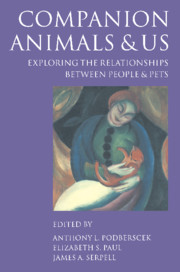Book contents
14 - Human–cat interactions: relationships with, and breed differences between, non-pedigree, Persian and Siamese cats
from Part III - Pets, families and interactions
Summary
INTRODUCTION
In recent years the domestic cat population has increased, with cats outnumbering dogs in many countries. This increase in popularity is reflected in the large number of studies on their behaviour and interactions with humans, some of which are summarized below.
Background
Karsh (1983, 1984) examined the development of a kitten's first relationship with a human and concluded that the sensitive period of socialization for cats was from two to seven weeks of age. These studies have been substantiated by Turner et al. (1986), who also expanded on these findings by including a greater number of influential factors in their study: genes of the father (also examined by McCune, 1995); genetic and modificatory influence of the mother; presence or absence of the mother during encounters with humans; curiosity (level of exploratory behaviour shown) and general indicators of fear in the presence of unknown humans; the effect of stroking the kitten during a sensitive phase of socialization (see also Cook & Bradshaw, 1996); and the effect of feeding the kittens as a facilitator of first close contact (Karsh & Turner, 1988; Turner, 1988, 1995a).
The behaviour of adult cats in their first encounters within a standardized laboratory setting with people unknown to them was studied by Mertens and Turner (1988). Here, interaction patterns between cats and men, women, boys and girls were compared. It was found not only that ethological methods could be used to observe and quantify interspecific interactions, but also that individual personality types amongst the cats were one of the most significant factors influencing their behaviour with people. It was also discovered that there were differences between men, women, boys and girls in the ways in which they interacted with the cats. For example, the adults in the study room vocalized towards the cat earlier and for longer than did the children. Mertens (1991) substantiated these findings with her observations of human–cat interactions in private households.
These studies were followed by an analysis of the influence of family size and the housing conditions of cats on interspecific interactions in home settings.
- Type
- Chapter
- Information
- Companion Animals and UsExploring the relationships between people and pets, pp. 257 - 272Publisher: Cambridge University PressPrint publication year: 2000



